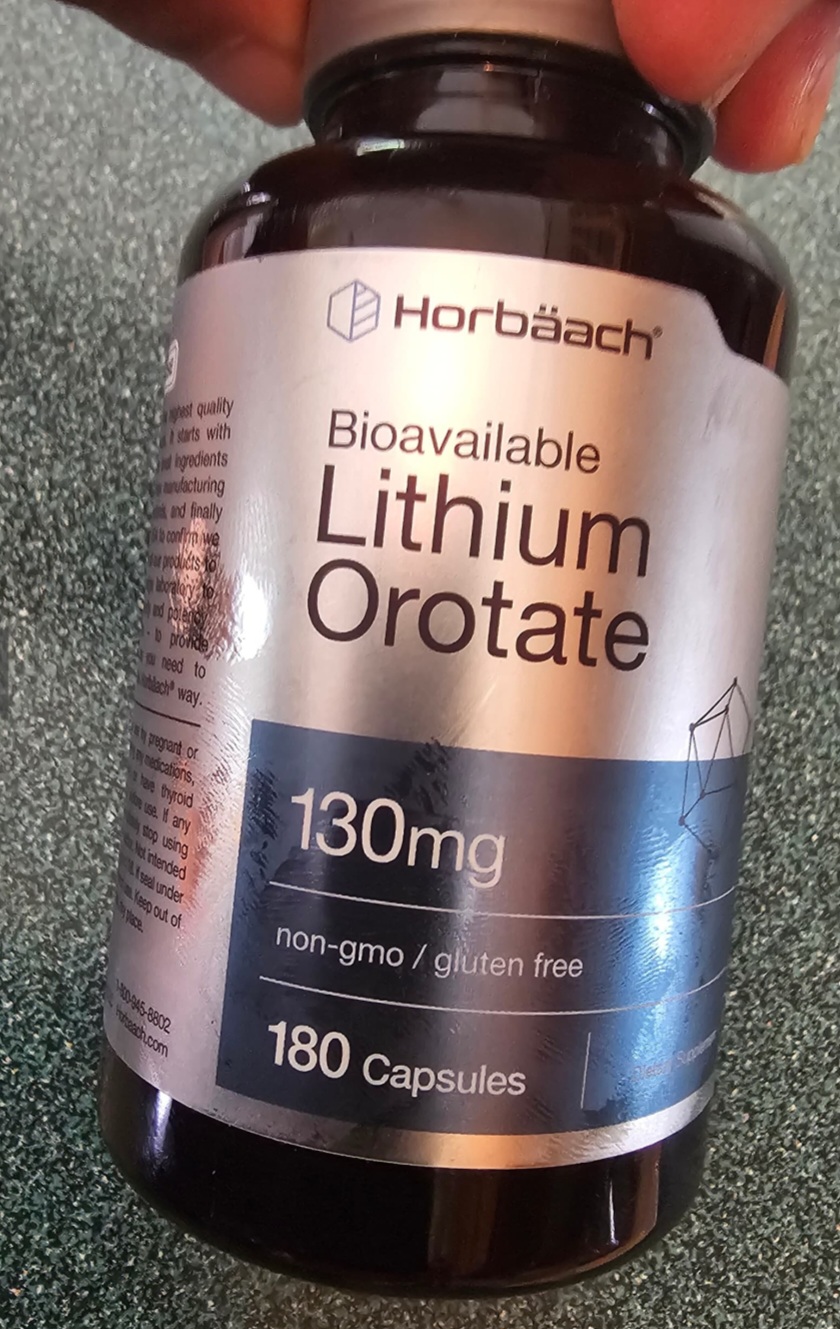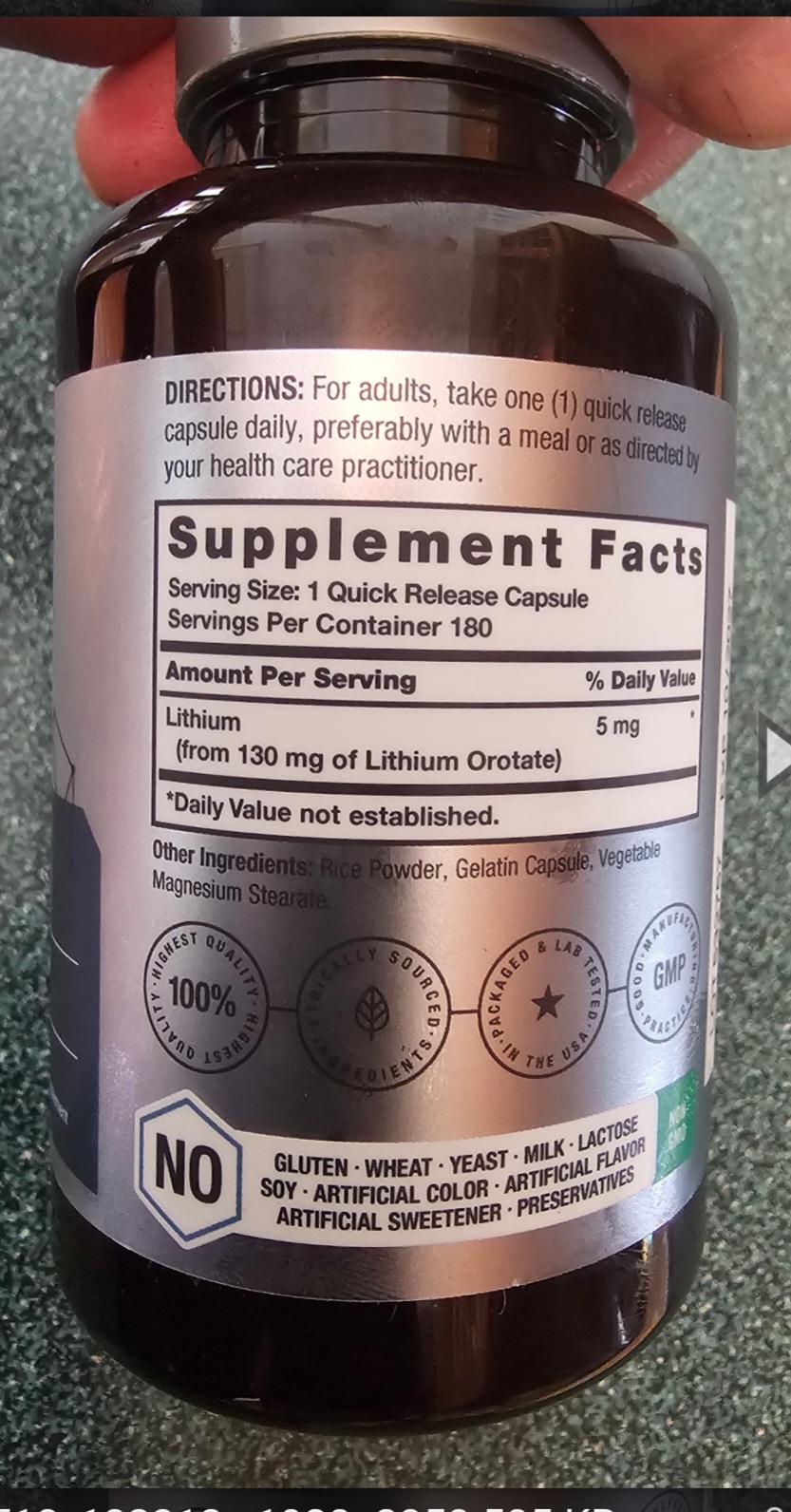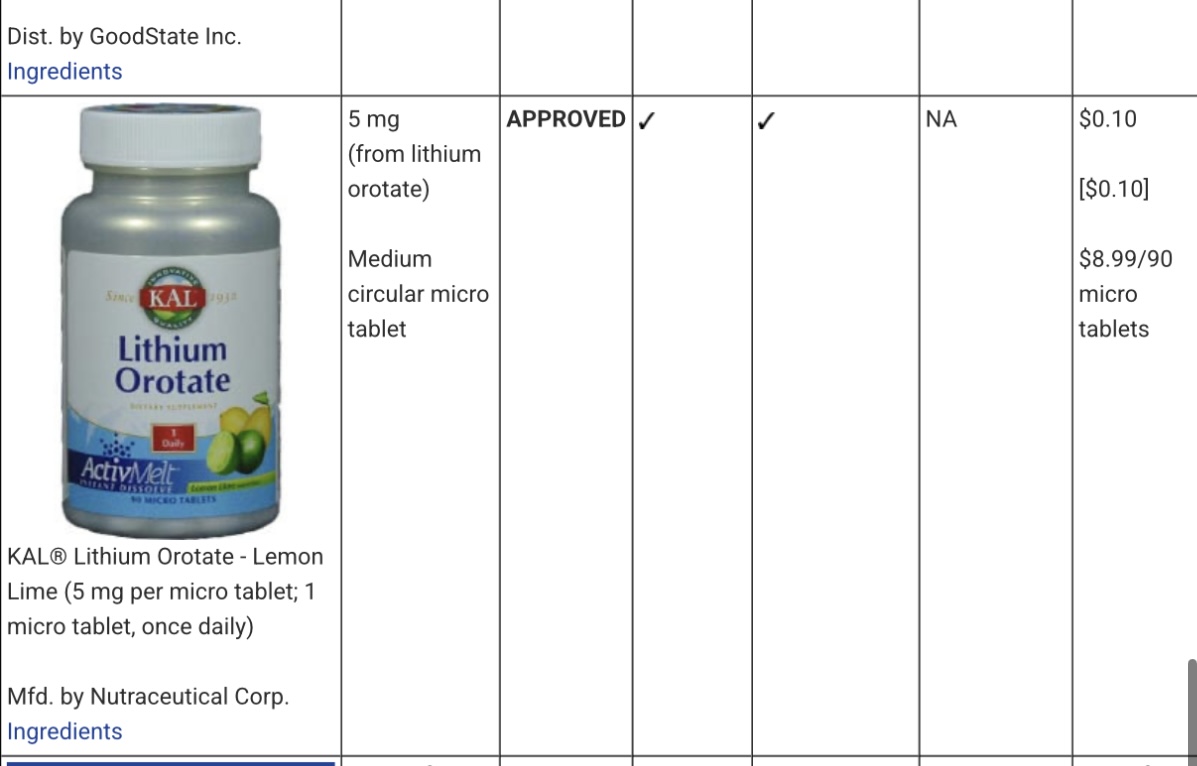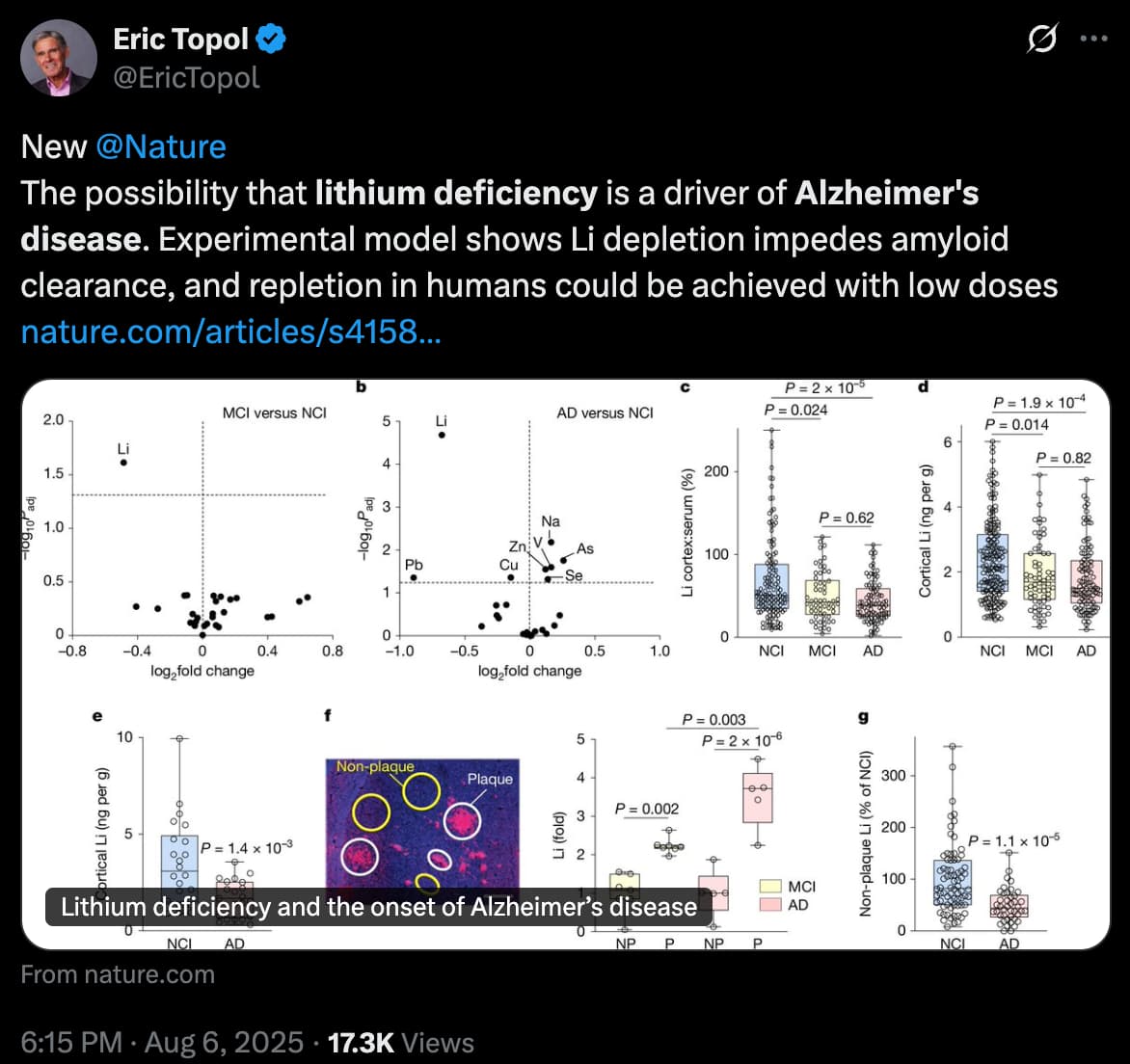I take lithium orotate 5mg 2x a week. 10-20mg blunts emotions, which can be useful when I’m in particularly stressful moments in life. I don’t like that feeling but it can be better than getting angry and doing or saying something I’d regret.
After reading this thread I might invest in some 1mg capsules and take those on days I don’t take the 5mg capsules.
I’ve settled on about 1.5 mg a day in the morning before school. It has worked wonders for my patience with 9th grade freshman boys in my science class. Which can still hit a nerve even after 35 years in the classroom.
I bought this brand on Amazon but then reading the reviews someone had written in to ask whether the capsules had 5 mg elemental Li or 5 mg LiOrotate. Turns out they are 5 mg LiOrotate which is a very small dose of elemental Li since ~ 130 mg of LiOrotate is ~ 5mg of elemental Li (0.1915 mg / capsule). Review pasted below…
Blockquote
M. Jury
1.0 out of 5 stars Dosage info is incorrect! Each capsule contains 0.1915 mg of elemental lithium, not 5 mg!
Reviewed in the United States on February 24, 2025
Here is an email reply I received from Double Wood Customer Support and following that is the email inquiry that prompter their response. The dosage info on the back of the label is incorrect, but the dosage info on the front of the label is correct. There is 5 mg of Lithium Orotate in each capsule which contains only 0.1915 mg of elemental lithium. If you want to get 5 mg of elemental lithium in a single capsule then you need to switch brands and get a 130 mg lithium orotate capsule. There are a number of other brands here on Amazon that sell 130 mg lithium orotate capsules with 5mg of elemental lithium.
Email Reply from Double Wood:
Customer Support
10:44 AM (6 minutes ago)
to me
Hi Michael,
Hope all is well. I made a follow up on your query about our Lithium Orotate supplement and our Specialist has clarified that each capsule contains 5mg of Lithium Orotate, which includes 0.1915mg of elemental lithium —not 5mg of elemental lithium.
We apologize for any confusion regarding the labeling, and we appreciate you bringing this to our attention.
Thanks,
Kris
Double Wood Int. Customer Support
My Second Email To Double Wood to Clarify and Confirm Their Initial Reply:
On Thursday, February 20, 2025 at 9:53 AM, Michael wrote:
Hi Kris,
Thank you for your reply. I would just like to confirm I understand your
reply.
If each capsule only contains 5mg of LIthium Orotate then the amount of
Lithium in each capsule is only 0.1915 mg and not the 5mg stated on the
back of the bottle. Is this what you mean?
Thank you.
Michael
Wow, that’s the brand I’ve been taking and figured the two capsules I take is 10mg, not less than 2mg. That’s one strike too many for Doublewood if this is the case.
Luke, when you questioned my lithium intake…I almost asked if my 130 mg lithium orotate had just 5 mg lithium… what level of lithium does yours have in it?
Now we know… very little.
Hmmm. I’ve been taking the “KAL” brand. On the front it says “Lithium Orotate 5mg”. But on the side it states “Lithium (from Lithium Orotate) 5 mg”
So I think I need to contact them for clarification as well.
It should mean elemental Lithium 5mg. It is a bit odd of Double Wood to report it wrongly.
Nice little chart of the serum level at different doses of elemental lithium.
High dose > 1.0/1.2mmol/L > 250 mg
Therapeutic dose = 0.6–0.8 mmol/L = 112-250 mg
Low dose’ = 0.2–0.6 mmol/L = 20-100 mg
Micro dose = unknown = 5-20 mg
Trace dose < 0.1mmol/L < 5 mg
Wow! Thanks for that. Seems I’ve been wasting my time with the DoubleWood brand. What a lousy product! I’ll be switching to a better source.
Can anyone share a better Lithium Orotate brand? Is Horbaach the best?
So I started taking 2 capsules of my 130 Lithium Orotate (Amazon)…10 mg total.
Seems good. Balances my TRT roid rage – kidding.
Yes, going by the paper, I think most of us could tolerate 10 mg, if not more. According to another paper, up to a third of the therapeutic dose is safe.
AIUI the therapeutic dose here is for mental health. Personally I want a concentration of lithium around the 25 microMolar range. The therapeutic concentration is perhaps 0.75 mmol. Viz 30 times that.
An issue with lithium is that it inhibits citrate carriers. I think that may be why higher doses are nephrotoxic.
Apparently high doses have a severe diuretic effect, which can lead to dehydration and kidney failure if the losses are not replenished, as they are often not in cases of an altered mental state. I’m sure there are other mechanisms.
By the way, what is bae, which is one of your remedies for a hangover.
Korean Pear Juice.
More preventative than remedy.
I’ve had been taking that one too. ![]() Noticed that @DrFraser links to the Nutricost brand in his blog. Says ‘Lithium (from lithium orotate) 5mg’. That’s the one I will order next.
Noticed that @DrFraser links to the Nutricost brand in his blog. Says ‘Lithium (from lithium orotate) 5mg’. That’s the one I will order next.
I just checked ConsumerLab.com and they tested that. It’s really 5mg and they marked it as “approved”, so you’re fine. I just ordered it myself.
I like Nutricost but ConsumerLab hasn’t tested that brand so I went with KAL.
Swanson, Advanced Research, Pure Encapsulations, and Solaray also advertise 5mg serving sizes and were all approved. So any of those brands should be good to go.
Lithium deficiency and the onset of Alzheimer’s disease 2025
The earliest molecular changes in Alzheimer’s disease (AD) are poorly understood1,2,3,4,5. Here we show that endogenous lithium (Li) is dynamically regulated in the brain and contributes to cognitive preservation during ageing. Of the metals we analysed, Li was the only one that was significantly reduced in the brain in individuals with mild cognitive impairment (MCI), a precursor to AD. Li bioavailability was further reduced in AD by amyloid sequestration. We explored the role of endogenous Li in the brain by depleting it from the diet of wild-type and AD mouse models. Reducing endogenous cortical Li by approximately 50% markedly increased the deposition of amyloid-β and the accumulation of phospho-tau, and led to pro-inflammatory microglial activation, the loss of synapses, axons and myelin, and accelerated cognitive decline. These effects were mediated, at least in part, through activation of the kinase GSK3β. Single-nucleus RNA-seq showed that Li deficiency gives rise to transcriptome changes in multiple brain cell types that overlap with transcriptome changes in AD. Replacement therapy with lithium orotate, which is a Li salt with reduced amyloid binding, prevents pathological changes and memory loss in AD mouse models and ageing wild-type mice. These findings reveal physiological effects of endogenous Li in the brain and indicate that disruption of Li homeostasis may be an early event in the pathogenesis of AD. Li replacement with amyloid-evading salts is a potential approach to the prevention and treatment of AD.
Inorganic Li salts, including the clinical standard lithium carbonate (Li2CO3, hereafter LiC), showed significantly elevated conductivity, indicative of increased ionization, relative to organic Li salts (P = 8 × 10−4; Fig. 5a and Extended Data Fig. 7a). Of the organic Li salts, lithium orotate (C5H3LiN2O4, hereafter LiO) showed the lowest conductance across a broad Li concentration range (Fig. 5a and Extended Data Fig. 7a) and was therefore selected for further comparison with the clinical standard LiC.
We have characterized a Li salt, lithium orotate, with reduced binding that can bypass amyloid sequestration in AD mouse models.
Editorial: Does lithium deficiency contribute to Alzheimer’s disease?
News: New hope for Alzheimer’s: lithium supplement reverses memory loss in mice
Most clinical trials of lithium have tested the form lithium carbonate. The team showed that amyloid plaques readily trap this form — but others, such as lithium orotate, avoid that fate. When the authors gave mice low doses of lithium orotate, it reversed disease-related brain damage and restored the animals’ memory. Lithium carbonate did not have the same benefits, potentially helping to explain the mixed results of earlier clinical trials.





